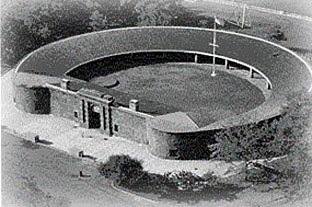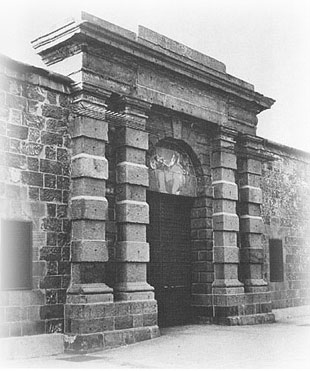Castle
Clinton
National Monument (NR)
  |
Castle Clinton
National Monument/earlier New York Aquarium (1896-1941)/earlier Emigrant
Landing Depot (1855-1890)/earlier Castle Garden (1824-1855)/originally West
Battery (1808-1811, renamed Castle Clinton, 1815). Lt. Col. Jonathan Williams
and John McComb, Jr. Open to the public: 7-5 daily. 212-344-7220.
Until recently, one of the most vitally involved structures in the city's life
and history. Built as West Battery for the War of 1812 to complement
Castle Williams across the waters on Governors Island (it never fired a shot in
anger), it was originally an island fortification some 300 feet offshore,
connected to Manhattan by a combination causeway bridge. Twelve years after the
war it was ceded to the city. As a civic monument it served for the
reception of distinguished visitors at the very edge of the nation (General
Lafayette, Louis Kossuth, President Jackson, Prince Albert). Remodeled as
a concert hall and renamed Castle Garden, it enjoyed a moment of supreme glory
in 1850 as the site of the P.T. Barnum-promoted American debut of the Swedish
soprano Jenny Lind. Only five years later it was transformed into the
Emigrant Landing Depot, run by N.Y. State, where some 7.7 million new Americans
were processed. Scandal led to its closure, and the processing of
immigrants was transferred to federal control, at the Barge Office in 1890 and
at Ellis Island in 1892. Changed by McKim, Mead & White, it became
the New York Aquarium until 1941.
It was doomed by Robert Moses' call
for its demolition to build approaches for his ill-fated harbor bridge to
Brooklyn -- today's Brooklyn-Battery Tunnel. A loud civic clamor and the
reported intervention of Eleanor Roosevelt miraculously saved it though it
languished inside a construction fence for decades. In 1946 the ruin was
named a National Historic Monument. In 1986 it became a ticket office for the
boats to National Park service attractions in the harbor.
Source: A.I.A Guide To New York City, 4th ed.